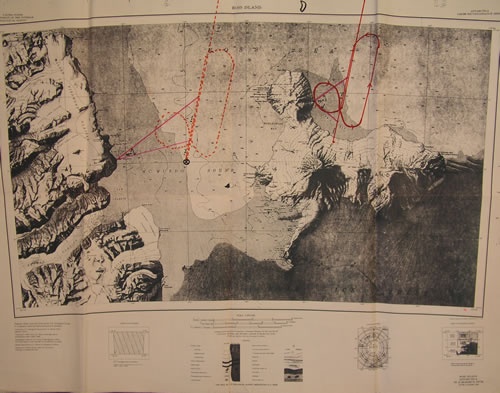

This map shows the flight path of Air New Zealand Flight TE901 on 28 November 1979 (solid red line) before it crashed into the lower slopes of Mt Erebus. The dashed line on the left shows the flight path the crew probably thought they were on.
In the detail image Mt Erebus is in the foreground.
The navigational coordinates
Some 14 months prior to the Erebus disaster, during the computerisation of Air New Zealand's routes, a typing error altered one of the navigational coordinates for the Antarctic flights. This moved the longstanding destination point some 27 nautical miles to the west. Instead of the instrument flight rules (IFR) route taking aircraft over Mt Erebus, en route to McMurdo Station, it would take them over flat sea ice, en route to the west of the Dailey Islands.
Changing coordinates
The position of the destination point changed three times in the period the Antarctic flights operated:
- 1977/78 - 166.48 east - seven flights are routed over Mt Erebus, en route to McMurdo Station
- 1978/79 - 164.48 east - seven flights over flat sea ice, en route to the west of the Dailey Islands
- 28 November 1979 - 166.58 east - Flight TE901 is routed over Mt Erebus, en route to McMurdo Station
A number of flight crews noticed the discrepancy in the months that followed, but it was first reported to Air New Zealand by Captain Simpson following his Antarctic flight on 14 November 1979. Simpson, who had attended the same route qualification briefing as the crew of Flight TE901, noted that there was a considerable distance between the destination point he had programmed from the flight plan (to the west of the Dailey Islands) and the actual position of the McMurdo Tactical Air Navigation system (TACAN) and McMurdo Station (the destination he had been briefed on). On his return Simpson told Captain Johnson of the airline's flight operations section. Johnson subsequently asked the airline's navigation section to check the position of the destination point.
The navigation section checked the coordinates on a computer printout of what they believed was the current flight plan. But this plan was the original that had not been used for 14 months. Their examination inevitably revealed no major discrepancy, but they did note a minor adjustment had been made to the position of McMurdo Station and decided to change the coordinates accordingly. They believed they had made a minor adjustment of 2.1 nautical miles to the longstanding destination point, but when translated into the current flight plan it was an adjustment of 27 nautical miles to the east. Instead of the IFR route taking TE901 over flat sea ice, as members of the flight crew of TE901 had been briefed, it would take them over Mt Erebus, a 3794-metre-high active volcano.
The adjustment was made in the airline's ground computer at 1.40 a.m. on 28 November 1979. Later that morning the flight crew of Flight TE901 were handed the adjusted 'correct' flight plan, but were not alerted to the adjustment either before or during their normal pre-flight dispatch briefing. After the briefing the crew proceeded with their pre-flight checks. This included manually entering the coordinates from the flight plan into the onboard computer and double checking that they were correct.
Next page: The flight
Further information
- The Erebus flight path controversy (NZALPA's Erebus website)

Community contributions